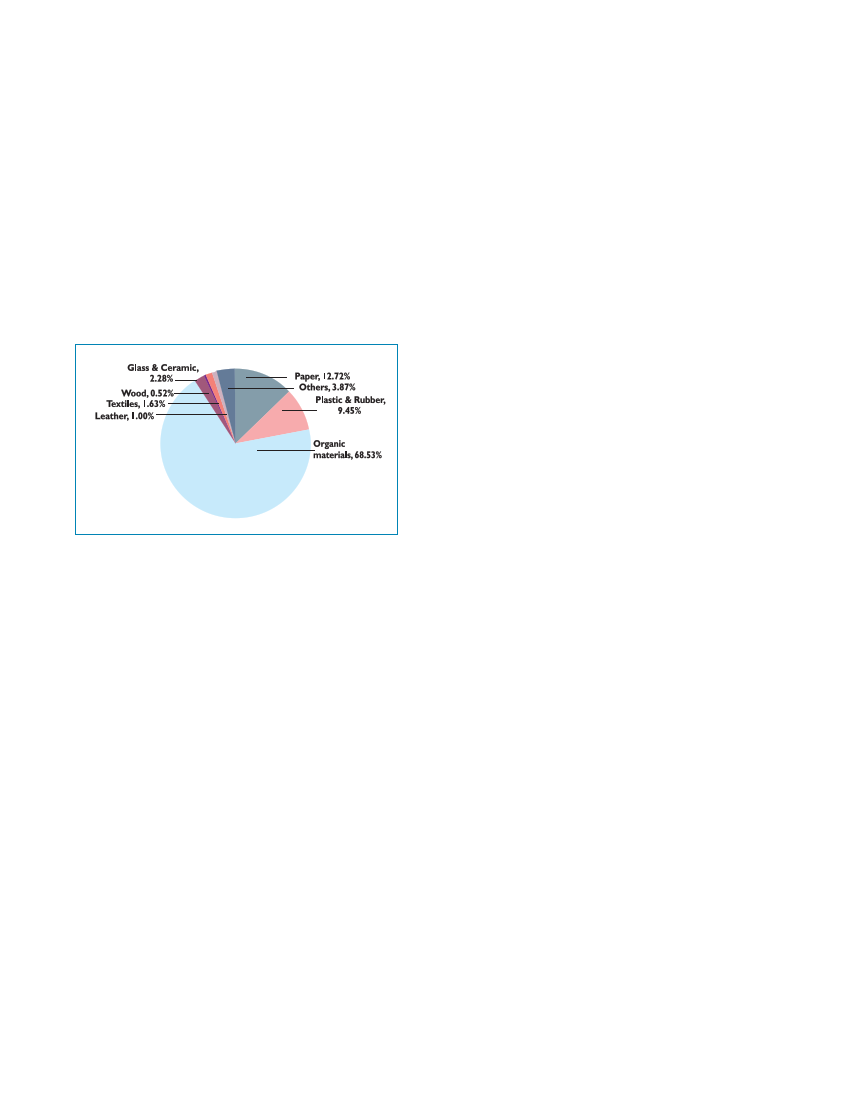
BEST PRACTICES ON SOLID WASTE MANAGEMENT OF NEPALESE CITIES
The composition of waste at source was found to be
paper 12.72 per cent, plastic & rubber 9.45 per cent,
organics 68.53 per cent, glass and ceramics 2.28 per
cent, wood 0.52 per cent, textiles 1.63 per cent, leather
1 per cent and other materials 3.87 per cent (Hetauda
municipality, 2008). Therefore, this data indicates that
1.4 tons of plastic wastes are generated each day in
Hetauda municipality. In order to reduce the plastic
waste in the municipal area, Hetauda municipality
is encouraging the use of textile bags instead of
plastic bags.
Chart 8: Composition of solid waste at source
Waste collection and recycling
Previously, women's groups from TLOs used to
distribute Suiro hooks to all member HHs in Wards 3
and 6 to collect plastics bimonthly. Now, the
Community Development Section of Hetauda
municipality has taken on the responsibility of
recovering plastic waste (Hetauda municipality, 2008
data). The municipality has hired one room (having
an area of 225 ft sq. [21 m2]) near the central bus park
for sorting plastics. The main stakeholders assisting
this project are: Clean Nepal, Yug Prabhat Youth Club,
Tole Bikas Sanstha, Sri Krishna Pranami, Hetauda
municipality, the Drinking Water Corporation and Nava
Jeevan Jyoti Club. The main input of the TLOs and
women's groups is plastic collection from HHs usually
on a bi-monthly or monthly basis.
Transport and final disposal
One rickshaw that can carry between 300kg and 500kg
has been provided by Hetauda municipality for
collecting and transporting the plastic waste. Hetauda
municipality dumps all of its waste beside the Rapti
River. The site is 1.5 km south of the east-west highway.
After the recovered plastic waste are sorted out at the
sorting centre, non-recyclable plastic waste are taken
to the dumping site on the Rapti river. During the field
visit, there were waste pickers and animals at the
dumping site and some of the deposited waste was
burning.
Organisational and
financial aspects
Two full-time employees have been engaged for
collecting and transporting plastic. The municipality
pays their salaries (NRs.2,500 per month). The
collected plastic is sold for NRs.6 per kg. It is
estimated that, in 2007, almost 1.5 tons of plastics
waste was being collected each month (Hetauda
municipality, 2007 data). Of this, 800-900kg each
month was sold for recycling purpose (Hetauda
municipality, 2007 data). Therefore, the total income
from the sale of recyclable plastic by this Suiro
Abhiyan in Hetauda municipality was NRs.5,000 per
month (Hetauda municipality, 2007 data). In order
to increase plastic recovery from HH waste, Hetauda
municipality distributed Suiro hooks free of cost,
initially with some operational training.
Major problems and issues
Suiro Abhiyan has had a positive impact not only on the
environment but also on the lives of women involved in
this initiative. Women involved in safely managing their
waste at HH level are also working together to build
links with other communities. Their experience has
increased knowledge regarding waste reduction and
recycling. In spite of these successes, challenges remain,
including management, co-ordination between the TLO
and the Hetauda municipality, building trust between
the stakeholders and the lack of a motor vehicle.
Conclusions and lesson learnt
It has been demonstrated that local people are willing
to participate in plastic reduction campaigns. This is a
very simple process leading to the reduction and safe
recovery of plastic. This movement, while concentrating
on plastic waste reduction and separation, has earned
a considerable income from recycling. Furthermore,
capacity building activities - education campaigns and
38